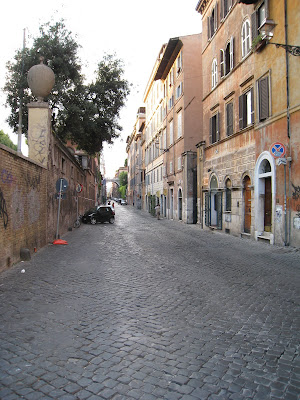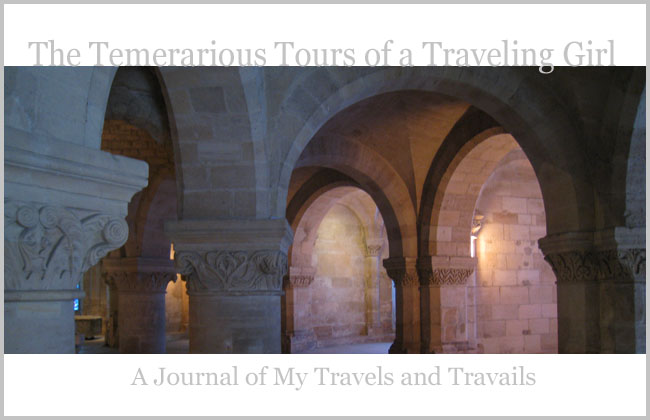I spent a good part of my last day in Rome not actually in Rome but in Viterbo, a small town about two hours north of Rome. Viterbo has one of best preserved medieval neighborhoods in Italy and during the Middle Ages, actually rivaled Rome in prestige. As a result, there are many more expensive buildings and churches in the town than might otherwise be expected. The train/bus ride from Rome was very picturesque, through rolling hills and farmland, and Viterbo itself, if you could take away the cars, feels like a town that time forgot. Unfortunately, since today was Monday, almost everything was closed, with the lucky exception of the church of Santa Maria Nuova, a Romanesque building from the eleventh century with a predictable dark, yet ethereal, interior. Five small chapels line the walls of the side aisles - three on the left and two on the right if you’re facing the high altar. Two of the chapels hold frescoes depicting the Crucifixion, one from the first half of the fourteenth century, the other from the very end of the thirteenth. A third chapel holds a fresco from the fifteenth century depicting the Virgin and Child enthroned with John the Baptist to the viewer’s left and Christ to the right, holding the cross in his left hand and motioning with his right hand to a Eucharistic chalice and host into which his blood flows from the wound in his side. All three are interesting in their own right, but together beg the question of why such a small church would have three separate images either of or relating to the Crucifixion. The fourteenth century fresco is particularly interesting because blood is shown gushing from Christ’s wounds in a style more typical of Northern Europe (as discussed by Caroline Bynum Walker in her recent book Wonderful Blood).

Santa Maria Nuova

Crucifixion #1

#2
 #3
#3
 The nave
The nave
I spent about three hours walking around Viterbo and was particularly impressed by the medieval part of the town as well as the Palazzo Papale, built in the thirteenth century and the site of five papal conclaves. The town’s cathedral, San Lorenzo, has a Renaissance façade but is a Romanesque building with a bell tower from the fourteenth century built with the same alternating bands of black and white as the cathedral in Siena. This day trip also confirmed for me (as if there had been any doubt) that I must learn Italian - outside Rome, there is no language crutch!

Viterbo's main square, the Piazza Plebescito, with the Palazzo del Podestà on the right and the Palazzo Communale on the left.

View over the rooftops to the other, newer side of the town

The Palazzo Communale
 The Chiesa del Gesù, where Simon de Montfort's sons stabbed Henry of Almain, Richard of Cornwall's son, to death during mass. It would be just another case of revenge (in this case for Simon's death at the Battle of Evesham), but Dante mentions the attack in the Inferno, in which he places Guy de Montfort, one of the attackers, in the seventh circle of Hell.
The Chiesa del Gesù, where Simon de Montfort's sons stabbed Henry of Almain, Richard of Cornwall's son, to death during mass. It would be just another case of revenge (in this case for Simon's death at the Battle of Evesham), but Dante mentions the attack in the Inferno, in which he places Guy de Montfort, one of the attackers, in the seventh circle of Hell.
 The Cathedral and bell tower of Viterbo
The Cathedral and bell tower of Viterbo

The Palazzo dei Papi, a reminder of Viterbo's former prestige.


 Pretty streets in the town
Pretty streets in the town

 I got back to Rome in the late afternoon and came back to the hotel to see St. Bridget’s rooms here at the convent. The sister who led me through the house was a fountain of information about the saint and explained to me the significance of the distinct habit worn by sisters of the order. The Rule was supposedly revealed to St. Bridget and is found in her Revelations and later combined with that of St. Augustine. The nuns wear a white circlet of cloth with two additional bands from front to back and side to side, forming a cross, over their navy blue veil. At the points where the bands intersect are crimson dots, five total, representing the five sufferings of Christ (circumcision, the agony in the garden, the betrayal, the flagellation, and the crucifixion?). There is a definite connection between the order and Christ’s crucifixion (Bridget’s Revelations detail the ongoing suffering of Christ due to mankind’s sinfulness and she wanted to die like Christ on the cross, which she semi-accomplished by dying on a wooden table), so depending on what I find in Florence and on my other day trips, I think St. Bridget may become a major focus of my thesis. It would be great if I could find a Brigittine church with fourteenth century artwork - maybe once I have internet again!
I got back to Rome in the late afternoon and came back to the hotel to see St. Bridget’s rooms here at the convent. The sister who led me through the house was a fountain of information about the saint and explained to me the significance of the distinct habit worn by sisters of the order. The Rule was supposedly revealed to St. Bridget and is found in her Revelations and later combined with that of St. Augustine. The nuns wear a white circlet of cloth with two additional bands from front to back and side to side, forming a cross, over their navy blue veil. At the points where the bands intersect are crimson dots, five total, representing the five sufferings of Christ (circumcision, the agony in the garden, the betrayal, the flagellation, and the crucifixion?). There is a definite connection between the order and Christ’s crucifixion (Bridget’s Revelations detail the ongoing suffering of Christ due to mankind’s sinfulness and she wanted to die like Christ on the cross, which she semi-accomplished by dying on a wooden table), so depending on what I find in Florence and on my other day trips, I think St. Bridget may become a major focus of my thesis. It would be great if I could find a Brigittine church with fourteenth century artwork - maybe once I have internet again!
This evening, I finally had Roman pizza from a pizzeria in Campo di Fiore, less than a minute from the convent. Later, I went on a walk down the Via Giulia, one street over from the Piazza Farnese and along the Tiber, then headed east towards the Pantheon to find a Giolotti, the gelaterie Dorothy recommended.
 "My" street
"My" street
 Via Guilia
Via Guilia
 I wonder if McDonald's intended to be ironic...
I wonder if McDonald's intended to be ironic...
 McDonald's - surely one of the "ignoble taverns" to which the inscription refers!
McDonald's - surely one of the "ignoble taverns" to which the inscription refers!
 It was easy to find (thanks to her directions) and packed, which is always a good sign. The gelato was amazing; definitely the best I’ve had so far, but I have yet to master the Italian skill of eating gelato neatly while walking.
It was easy to find (thanks to her directions) and packed, which is always a good sign. The gelato was amazing; definitely the best I’ve had so far, but I have yet to master the Italian skill of eating gelato neatly while walking.  As I ate (and dripped) I headed back towards the Pantheon, but, absorbed as I was, made a wrong turn and ended up in front of the Palazzo di Giustizie on the other side of the river. From there, I could see St. Peter’s and the colors were spectacular as the sun began to set. I decided to head along the Tiber towards St. Peter’s as the sunset grew more intense and got a wonderful view and some great pictures.
As I ate (and dripped) I headed back towards the Pantheon, but, absorbed as I was, made a wrong turn and ended up in front of the Palazzo di Giustizie on the other side of the river. From there, I could see St. Peter’s and the colors were spectacular as the sun began to set. I decided to head along the Tiber towards St. Peter’s as the sunset grew more intense and got a wonderful view and some great pictures.

The Palazzo di Giustizie

View along the Tiber to St. Peter's

Castel Sant'Angelo


Gelato count: 3
 Crucifixion #1
Crucifixion #1 Viterbo's main square, the Piazza Plebescito, with the Palazzo del Podestà on the right and the Palazzo Communale on the left.
Viterbo's main square, the Piazza Plebescito, with the Palazzo del Podestà on the right and the Palazzo Communale on the left. View over the rooftops to the other, newer side of the town
View over the rooftops to the other, newer side of the town The Palazzo Communale
The Palazzo Communale







 Castel Sant'Angelo
Castel Sant'Angelo
 Gelato count: 3
Gelato count: 3













No comments:
Post a Comment